Jurassic Farm
A small group of determined visionaries on a mission to resurrect a species of prehistoric bovines, called aurochs, which have been extinct for centuries.
Jurassic Farm
A small group of determined visionaries on a mission to resurrect a species of prehistoric bovines, called aurochs, which have been extinct for centuries.
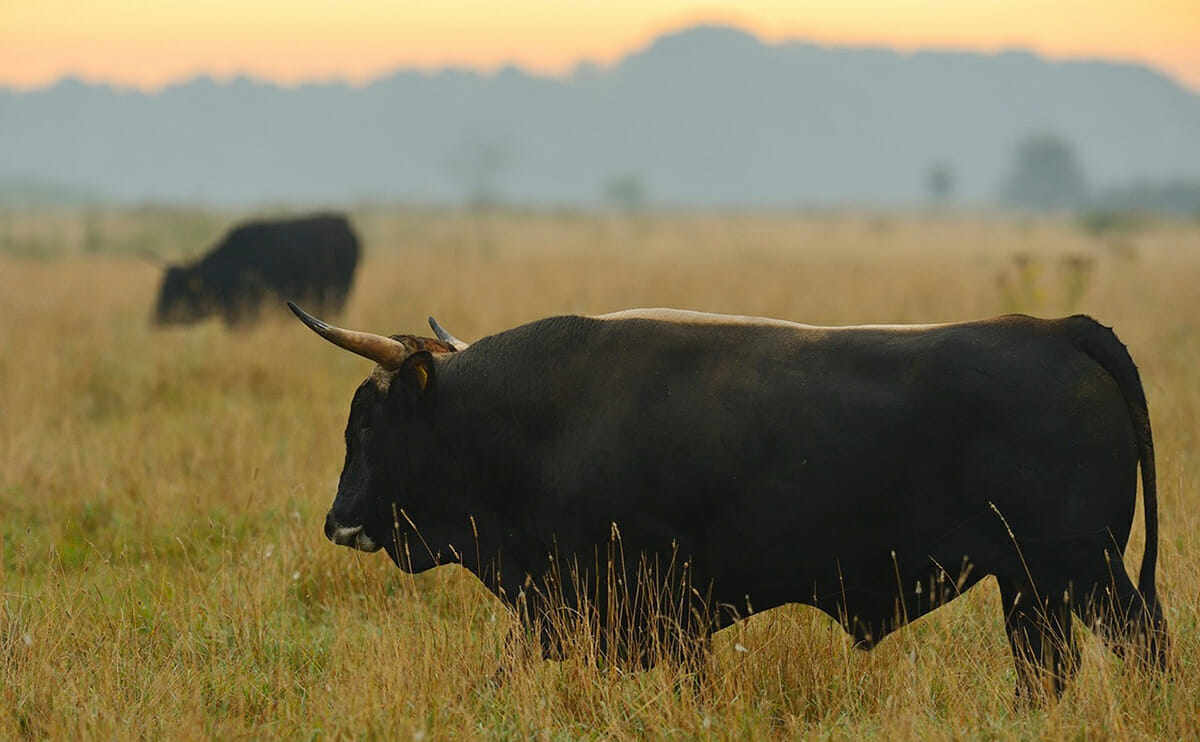
The 21st-century back-to-the-farm movement stems from our yearning to escape the artificiality of modern urban life.
Yet the domesticated plants and animals now found in most gardens and farms are themselves artificial, the results of extensive human meddling, cross-breeding and genetic manipulation. Mankind began engineering what we now call “farm animals,” including cattle, all the way back in the Neolithic period, between 10,000 and 5,000 B.C.
Try as you might, you won’t find an untamed Jersey cow that originated naturally in the wild, because no such thing exists — just like there’s no such thing as a wild labradoodle. Cattle are entirely human-made, molded over thousands of years from long extinct, ancestral species.
But that could change.
A small group of determined visionaries are on a mission that seems ripped straight from the plot of a (farm-obsessed) sci-fi novel: Resurrecting a species of prehistoric bovines, called aurochs, which have been extinct for centuries.
Wild aurochs were bigger and leaner than domesticated cattle. Centuries of human intervention and selective breeding gradually transformed them into docile, milk-heavy dairy cows and beef cattle. Most Americans have only ever heard of aurochs when name-dropped in Game of Thrones, and likely assume they’re mythical creatures. Not only were they real, they were once dominant: million-strong herds thundered across Eurasia and North Africa. Sadly, The last recorded aurochs perished in a Polish forest in 1627.
The quest to resurrect aurochs dates all the way back to the 1920s. Two German zookeepers, the Heck brothers, tried to recreate them by back-breeding various types of 20th-century cattle thought to possess aurochs-like characteristics. By the 1930s, the Hecks had declared success, but the resultant animal – now known as “Heck cattle” – were only vaguely reminiscent of actual aurochs, and much smaller.
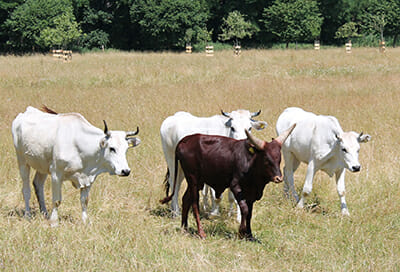
The possible great-great-grandparents of the future aurochs; three Chianina cows and one Watusi bull from the first Uruz Project breeding herd in Lorsch, Germany. / Courtesy Claus Kropp.
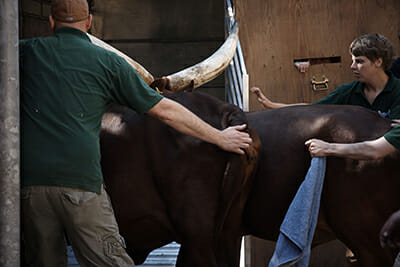
The foundation animals of a future Uruz Project herd being transported to their new home. / Courtesy Arend de Haas, True Nature Foundation.
Fast-forward to 1996, when a new group of German researchers picked up where the Heck brothers left off, cross-breeding Heck cattle with yet more ancient-looking bovine breeds from Italy and Spain. This new crossbreed was eventually dubbed “Taurus cattle,” and was a step closer to aurochs – taller and bigger, with a more aurochs-like snout. Things started to go a little haywire after 2003 when Taurus herds were also established in Hungary, Denmark and Latvia, each of which began to introduce its own idiosyncratic variety of breeds (African cattle, Holsteins) to the genetic mix. While Taurus cattle are definitely more aurochs-like than Heck cattle, by now there is no consistency.
Now the Dutch are leading the way in this race backward to the pre-domesticated past.
“In early 2008 we started the Tauros Programme, our initiative to breed back a bovine as close as can be to aurochs, with the end-goal of having free-living aurochs in European natural areas again,” says Ronald Goderie, director of the Taurus Foundation, the Dutch parent organization of the Tauros Programme. (Yes, the names are confusing – the Taurus Foundation adopted the Greek word for bull, “Tauros” with an o, to differentiate themselves from the earlier unrelated Taurus cattle.) “We started this initiative because large herds of natural grazers are necessary to preserve European open landscapes and biodiversity.”
Tauros researchers wiped the slate clean and started fresh with no genetic contributions from Heck cattle or other artificial crossbreeds, instead launching a scientifically based attempt to coax the aurochs phenotype from ancient DNA deeply embedded in the genes of a cadre of “primitive” cattle breeds still surviving in southern Europe. Tauros researchers compare the genes of existing breeds to that of the aurochs, whose DNA has been sequenced by the University of Dublin from bones found in Britain, and use that information to help them breed backward for the right characteristics.
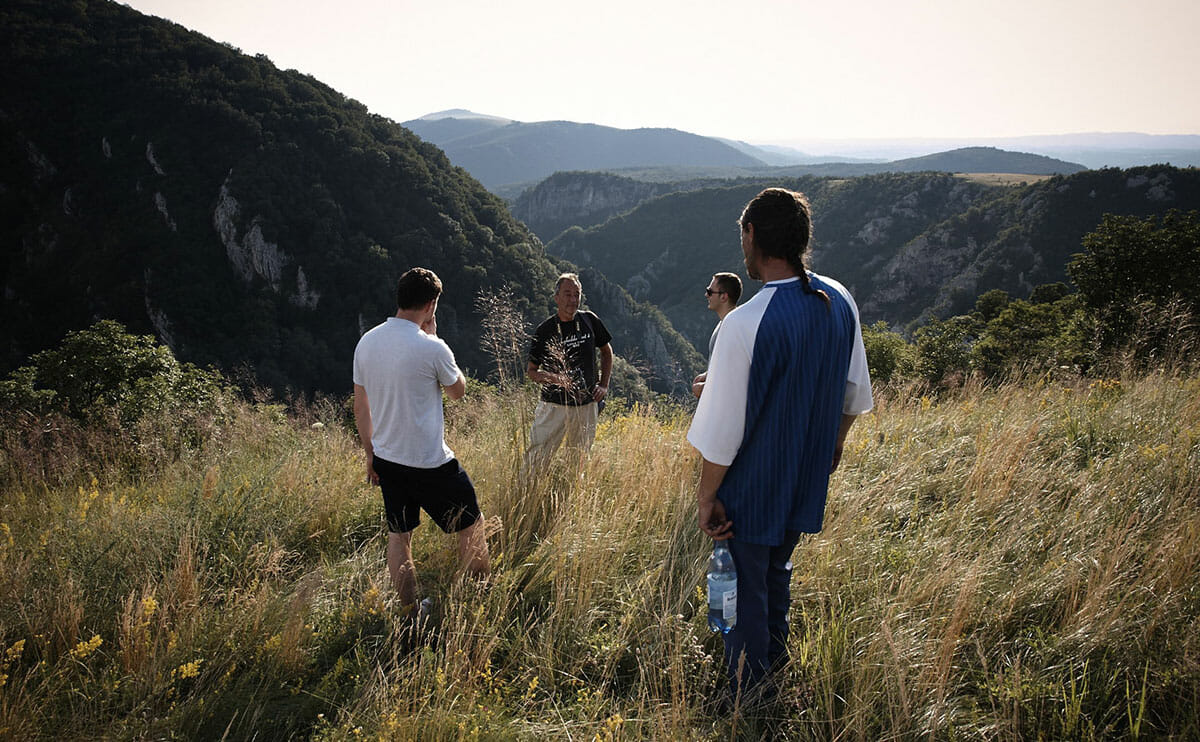
“Our goal is not only to have an animal that looks like an aurochs but also genetically comes as close as can be,” says Goderie.
Tauros is not alone in this quest. In fact, there is a bit of drama in the world of aurochs de-extinction. A brand-new Dutch aurochs venture, the Uruz Project, was recently launched by Henri Kerkdijk-Otten, one of the original Tauros researchers who left and started his own initiative over disagreements about the best way to breed back aurochs.
“I joined the Taurus Foundation in 2008 and helped launch the Tauros Programme, but became dissatisfied with what I felt was the use of too many cattle breeds. So I left in 2012 and founded the Megafauna Foundation, later redubbed to True Nature Foundation,” says Kerkdijk-Otten. “We use only four cattle breeds to stabilize the genome as quickly as possible.”
Of course, Kerkdijk-Otten cautions, even a carefully reverse-engineered aurochs will not be an exact copy of the beast that once existed. “But neither would a suriving wild aurochs be, if the species had survived till today. The purpose of the Uruz Project is not to replicate some outdated stage of aurochs development, but to be an aurochs for the 21st century,” he says.
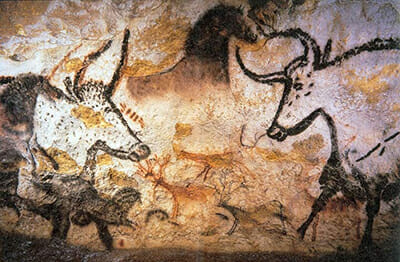
On the walls of Lascaux Cave in France, in the Upper Paleolithic era (around 17,000 B.C.), early humans painted aurochs, which they hunted. / Courtesy Prof Saxx.
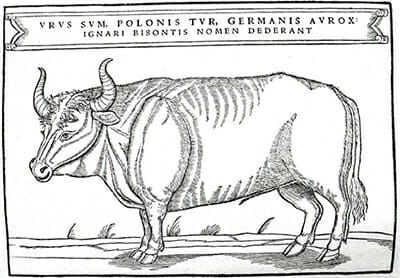
An illustration of an aurochs from a book published in 1556 by Sigismund von Herberstein; the Latin words mean, ‘I’m an aurochs.’ Since aurochs were already a critically endangered species by 1556, the illustrator might never have seen an one, as the drawing’s proportions (hindquarters too fat, legs too short for a real aurochs) aren’t entirely accurate.

A lifelike model of an aurochs next to a human figure for size comparison. / Courtesy Pachyornis at the Breedling-back Blog.
So, is there a future where diners are chowing down on farm-raised aurochs burgers?
“Beef from organic primitive aurochs-like cattle is already sought after and sells for a high price per kilo, even by top chefs in Europe,” Kerkdijk-Otten avows. “Their meat almost has a wild taste: It is marbled, tender and juicy and full of omega 3 and 6, vitamins like B12 and E, and iron.”
But let’s not forget why we aren’t farming aurochs today: they produced less meat and less milk than modern breeds. The entire purpose of the domestication process was to develop an animal with maximum food and power output.
The entire purpose of the domestication process was to develop an animal with maximum food and power output.
The real goal of the aurochs de-extinction movement is to re-introduce a wild species, not create a gargantuan, uncontrollable, sinewy farm beast.
“Our aurochs will be only used to populate wild ecosystems in Europe,” says Goderie. “There’s not very much sense in starting the domestication process all over again.”
The Tauros Programme, working with Rewilding Europe, already has hundreds of second- and third-generation crossbreed cattle in Spain, Portugal, Croatia and the Netherlands, and its researchers are optimistic that within another few generations a new aurochs type will emerge from their experiment.
Uruz, for its part, is just setting up its initial herds, the first of which lives in the town of Lorsch, Germany at the Lauresham Open Air Laboratory for Experimental Archaeology on the grounds of a medieval abbey, where they’re tended to by historian Claus Kropp. Another herd grazes in the Dutch town of Breda, with more planned soon for Romania and Spain.
Despite the Dutch rift, the door is still open for cooperation. “We don’t see the Tauros Programme and the other projects as rivals,” says Goderie. “There’s enough room for different initiatives, and if I could arrange a budget I would very much like to organize a ‘best-practices’-congress.”
But what about the ultimate de-extinction dream – cloning? Sadly, Steven Spielberg will not be releasing Jurassic Farm anytime soon: although the ancient aurochs DNA has been sequenced, the necessary ingredient for cloning ”“ viable tissue samples from fresh aurochs meat or blood – has long since disappeared. Some hope that viable DNA may be extracted from preserved bones and horns, but such technology does not exist at this time.
For now, even the most high tech geneticists must do things the old-fashioned way: Through the careful selection and breeding of the aurochs’ living descendents – if we are ever to hear those heavy hoofbeats again.
Top photo: A first-generation Tauros bull named “Manolo Uno,” who is a cross between an Italian Maremmana primitivo bull and a Spanish Pajuna cow. / Courtesy Staffan Widstrand and Rewilding Europe.
Follow us
This work is licensed under a Creative Commons Attribution-NoDerivatives 4.0 International License.
Want to republish a Modern Farmer story?
We are happy for Modern Farmer stories to be shared, and encourage you to republish our articles for your audience. When doing so, we ask that you follow these guidelines:
Please credit us and our writers
For the author byline, please use “Author Name, Modern Farmer.” At the top of our stories, if on the web, please include this text and link: “This story was originally published by Modern Farmer.”
Please make sure to include a link back to either our home page or the article URL.
At the bottom of the story, please include the following text:
“Modern Farmer is a nonprofit initiative dedicated to raising awareness and catalyzing action at the intersection of food, agriculture, and society. Read more at <link>Modern Farmer</link>.”
Use our widget
We’d like to be able to track our stories, so we ask that if you republish our content, you do so using our widget (located on the left hand side of the article). The HTML code has a built-in tracker that tells us the data and domain where the story was published, as well as view counts.
Check the image requirements
It’s your responsibility to confirm you're licensed to republish images in our articles. Some images, such as those from commercial providers, don't allow their images to be republished without permission or payment. Copyright terms are generally listed in the image caption and attribution. You are welcome to omit our images or substitute with your own. Charts and interactive graphics follow the same rules.
Don’t change too much. Or, ask us first.
Articles must be republished in their entirety. It’s okay to change references to time (“today” to “yesterday”) or location (“Iowa City, IA” to “here”). But please keep everything else the same.
If you feel strongly that a more material edit needs to be made, get in touch with us at [email protected]. We’re happy to discuss it with the original author, but we must have prior approval for changes before publication.
Special cases
Extracts. You may run the first few lines or paragraphs of the article and then say: “Read the full article at Modern Farmer” with a link back to the original article.
Quotes. You may quote authors provided you include a link back to the article URL.
Translations. These require writer approval. To inquire about translation of a Modern Farmer article, contact us at [email protected]
Signed consent / copyright release forms. These are not required, provided you are following these guidelines.
Print. Articles can be republished in print under these same rules, with the exception that you do not need to include the links.
Tag us
When sharing the story on social media, please tag us using the following: - Twitter (@ModFarm) - Facebook (@ModernFarmerMedia) - Instagram (@modfarm)
Use our content respectfully
Modern Farmer is a nonprofit and as such we share our content for free and in good faith in order to reach new audiences. Respectfully,
No selling ads against our stories. It’s okay to put our stories on pages with ads.
Don’t republish our material wholesale, or automatically; you need to select stories to be republished individually.
You have no rights to sell, license, syndicate, or otherwise represent yourself as the authorized owner of our material to any third parties. This means that you cannot actively publish or submit our work for syndication to third party platforms or apps like Apple News or Google News. We understand that publishers cannot fully control when certain third parties automatically summarize or crawl content from publishers’ own sites.
Keep in touch
We want to hear from you if you love Modern Farmer content, have a collaboration idea, or anything else to share. As a nonprofit outlet, we work in service of our community and are always open to comments, feedback, and ideas. Contact us at [email protected].by Kristan Lawson, Modern Farmer
September 10, 2014
Modern Farmer Weekly
Solutions Hub
Innovations, ideas and inspiration. Actionable solutions for a resilient food system.
ExploreExplore other topics
Share With Us
We want to hear from Modern Farmer readers who have thoughtful commentary, actionable solutions, or helpful ideas to share.
SubmitNecessary cookies are absolutely essential for the website to function properly. This category only includes cookies that ensures basic functionalities and security features of the website. These cookies do not store any personal information.
Any cookies that may not be particularly necessary for the website to function and are used specifically to collect user personal data via analytics, ads, other embedded contents are termed as non-necessary cookies.
Where can I buy a Aurochs Bull